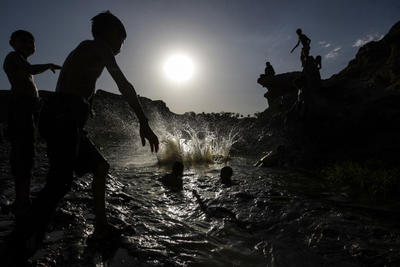In the 66 years since independence Pakistan’s per capita water availability has declined from 5000 m3 to 1000 m3 of water per capita; about the same level as Ethiopia and Libya. If the depletion of water continues at this rate, Pakistan’s water shortfall could be five times the amount of water that can presently be stored in the existing reservoirs by 2025. Most disturbingly, Pakistan’s policy makers are oblivious to these challenges, and water distribution and management have been neglected processes.
Due to Pakistan’s increasing water scarcity, and Pakistan’s and India’s mutual proclivity to blame the other, the risk of conflict between the two countries over shared river resources is likely to escalate. Pakistani media and politicians blame India for controlling the flow of water to the detriment of Pakistan. But such a discourse merely diverts policymakers and the public from an impending crisis that is largely of Pakistan’s own making, and to which there is no short-term solution.
Paradoxically, India and Pakistan resolved the contentious water issue in 1960 through the Indus Water Treaty. Pakistan’s four provinces then took 44 years after independence to sign the Water Apportionment Accord in 1991. Notwithstanding the Accord, water remains a highly contentious issue effectively stalling the building of any new reservoirs in the last 40 years.
There are several reasons for the reduced availability of water in Pakistan, some of which are admittedly natural.
Pakistan’s population is ballooning, meaning that more are consuming water. Climate change is also making glacial water supply uncertain and reduced snowmelts can lead to less water in the system.
However, Pakistan is also wasting water. Rainwater is squandered due to the lack of catchment and storage reservoirs. Pakistan’s existing water storage infrastructure is ageing and is unable to cope with the rising demand. Sedimentation in the three main dams has reduced their holding capacity by a third, leaving Pakistan with a dangerously low water storage capacity of only 30 odd days. Meanwhile, illegal logging and removal of forest cover have denuded Pakistan’s rangelands thus causing annual flash floods that result in heavy collateral damage.
Pakistan is estimated to lose 13 million cusecs of water every year into the sea. This seawater encroachment damages land otherwise suitable for agriculture up to 100 kilometres inland during periods of reduced river flow. Additionally, while the developing world uses on average 75 per cent of its total water usage for agriculture, Pakistan uses nearly 90 per cent. With barely 10 per cent left for drinking, household usage, sanitation and industrial purposes, it is no wonder that a third of the population does not have access to safe drinking water.
From within its usage for agriculture two-thirds of water is wasted due to archaic agricultural practices. Since many influential landowners are also powerful politicians benefitting from the status quo, they resist all attempts to change — only to maintain some of the lowest productivity rates in the world per unit of water and per unit of land.
Aside from agriculture, the generally careless way Pakistanis use water also needs reform. Life style changes and wasteful habits are adding to the wastage. Household usages are charged almost always on a fixed basis, encouraging excessive wastage.
Recovering only 24 per cent of its annual overhaul and maintenance, the cost of Pakistan’s canal water irrigation system is financially unsustainable. A Planning Commission report disclosed that the rest of the money for overhaul and maintenance comes in subsidies. This low cost to the user breeds wastage and thus a national loss.
In addition, Pakistan is also contaminating its water, which reduces its usability. Untreated industrial and domestic effluent is being discharged into rivers, while the unregulated use of pesticides from farms is finding its way into streams and ground water.
Instead of passing blame, Pakistan needs to implement domestic policies to prevent waste and devise better management methods to reverse this looming crisis. The situation, if not tackled with urgency and forcefulness, will aggravate discord with India and exacerbate inter-provincial disharmony in Pakistan.
Sajjad Ashraf is an adjunct professor, Lee Kuan Yew School of Public Policy at the National University of Singapore and an associate fellow at the Institute of Southeast Asian Studies, Singapore. He is a former member of Pakistan Foreign Service 1973-2008.


What the author of the essay failed to say while making his dramatic opening statement that Pakistan’s per capita water availability has shrunk from 5000 m3 to 1000 m3 in 66 years is that (West) Pakistan’s population has increased over four times from 34 million in 1951 to 179 million in 2012. Obviously total water-flow cannot increase and with such rapidly rising population, per capita availability will come down. Besides planning more storage dams to store water which would otherwise flow into the sea and simpler check dams to store rain water, all Asian countries need to plan their population growth to ensure there is water availability.
The article clearly says: Pakistan’s population is ballooning, meaning that more are consuming water.